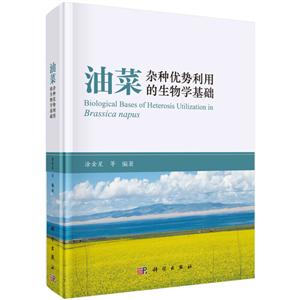-
>
四千年農夫 中國、朝鮮和日本的永續農業
-
>
(精)中華古樹名木(全2冊)
-
>
線辣椒優質高產栽培
-
>
生命的藝術:動物解剖學的神秘歷史之旅
-
>
正確使用農藥知識問答
-
>
龍眼譜:外二種
-
>
迷你花園:打造你的玻璃生態瓶
油菜雜種優勢利用的生物學基礎 版權信息
- ISBN:9787030585455
- 條形碼:9787030585455 ; 978-7-03-058545-5
- 裝幀:一般膠版紙
- 冊數:暫無
- 重量:暫無
- 所屬分類:>
油菜雜種優勢利用的生物學基礎 本書特色
涂金星等編著的《油菜雜種優勢利用的生物學基礎(精)》主要是就油菜雜種優勢利用中的基礎生物學問題,從分子生物學的角度,對涉及油菜雜種優勢利用中,細胞質雄性不育,細胞核雄性不育,自交不親和以及化學殺雄等途徑的分子機理,油菜遺傳資源拓展與作物雜種優勢形成的遺傳基礎等方面進行了較為詳細的闡述。
油菜雜種優勢利用的生物學基礎 內容簡介
本書針對傅廷棟院士主編的《雜交油菜的育種與利用》一書涉及的一些生物學基礎問題,總結了近20年來的研究進展,系統闡述了該領域的相關問題。在基礎部分,介紹了蕓薹屬物種染色體組成和基因組信息、遺傳標記和SNP芯片開發與利用,以及植物花器發育;在油菜雜種優勢利用的授粉系統部分,介紹了油菜細胞核雄性不育、細胞質雄性不育的生物學基礎,油菜自交不親和性的遺傳和分子機制,以及油菜化學殺雄的生物學機制;在雜種優勢形成基礎和利用方面,對雜種優勢遺傳基礎、表觀修飾和基因的差異表達進行了多個層次的論述,介紹了利用近緣種多樣性拓展甘藍型油菜遺傳差異的具體方法及材料的利用。
油菜雜種優勢利用的生物學基礎 目錄
**章 蕓薹屬基因組研究 1
**節 蕓薹屬物種的分類及在科學研究和農業中的重要性 1
第二節 油菜分子細胞學研究進展 8
第三節 油菜遺傳圖譜 17
第四節 油菜基因組研究和信息資源 22
第五節 油菜SNP 芯片開發及應用 33
參考文獻 40
第二章 植物花器發育的生物學基礎 49
**節 植物花器官的分化 49
第二節 植物花藥發育細胞學基礎 67
第三節 植物花藥發育基因調控 74
參考文獻 94
第三章 油菜細胞核雄性不育的生物學基礎 108
**節 油菜細胞核雄性不育的類型 108
第二節 油菜細胞核雄性不育的細胞學特征 110
第三節 油菜細胞核不育相關基因的克隆與功能分析 122
第四節 利用油菜細胞核雄性不育研究的新進展 147
參考文獻 151
第四章 油菜細胞質雄性不育的生物學機制 155
**節 油菜細胞質雄性不育的遺傳與特征 155
第二節 油菜細胞質類型的鑒定和主要的胞質類型 157
第三節 油菜細胞質雄性不育基因及其作用機制 166
第四節 油菜細胞質雄性不育恢復基因的遺傳及定位 173
第五節 油菜細胞質雄性不育恢復基因及作用機制 179
第六節 環境對細胞質雄性不育的影響及生態型不育 185
參考文獻 187
第五章 油菜自交不親和性生物學 196
**節 植物自交不親和性概述 196
第二節 蕓薹屬自交不親和性 198
第三節 甘藍型油菜自交不親和性 207
參考文獻 214
第六章 油菜化學殺雄雜種利用研究 219
**節 油菜化學雜交劑的類型 220
第二節 油菜化學雜交劑的使用方法與效果 224
第三節 油菜化學殺雄的生物學機制 228
第四節 油菜化學殺雄雜交制種技術 235
參考文獻 236
第七章 作物雜種優勢的遺傳與分子基礎 241
**節 雜種優勢基本假說 241
第二節 雜種優勢遺傳基礎解析的試驗設計 242
第三節 雜種優勢形成的超顯性假說的分子證據 244
第四節 雜種優勢形成的顯性假說的分子證據 245
第五節 雜種優勢形成的上位性假說的分子證據 246
第六節 三種遺傳效應和諧調控雜種優勢的證據 247
第七節 自交衰退的遺傳學基礎 247
第八節 基于全基因組關聯分析的雜種優勢遺傳基礎 248
第九節 源庫平衡關系與作物雜種優勢 249
第十節 雜種優勢形成的分子生物學基礎 251
第十一節 雜種優勢預測 255
第十二節 雜種優勢基礎研究的展望 259
參考文獻 261
第八章 油菜種質資源創新與雜種優勢利用 267
**節 油菜種質資源創新 267
第二節 油菜的雜種優勢利用 277
第三節 雜交種親本選配方法 280
參考文獻 286
Contents
Chapter 1 Brassica genome research 1
Section 1 Classification of Brassica species and their importance in scientific research and agriculture 1
Section 2 Advances in molecular cytology of Brassica napus 8
Section 3 Genetic map of Brassica napus 17
Section 4 Genomic research and information resources of Brassica napus 22
Section 5 Development and application SNP chips of Brassica napus 33
References 40
Chapter 2 The biological bases of plant flower development 49
Section 1 Differentiation of plant flower organs 49
Section 2 Cytological bases of plant anther development 67
Section 3 Gene regulation during plant anther development 74
References 94
Chapter 3 Biological bases of nuclear male sterility in Brassica napus 108
Section 1 Types of nuclear male sterility in Brassica napus 108
Section 2 Cytological features of nuclear male sterility in Brassica napus 110
Section 3 Cloning and functional analysis of nuclear sterility related genes in Brassica napus 122
Section 4 Progresses in the study of nuclear male sterility in Brassica napus 147
References 151
Chapter 4 Biological mechanisms of cytoplasmic male sterility in Brassica napus 155
Section 1 Inheritance and characteristics of cytoplasmic male sterility in Brassica napus 155
Section 2 Identification of cytoplasmic types and main cytoplasmic types in Brassica napus 157
Section 3 Cytoplasmic male sterility genes and their mechanisms in Brassica napus 166
Section 4 Inheritance and mapping of the restorer genes of cytoplasmic male sterility in Brassica napus 173
Section 5 The restorer genes of cytoplasmic male sterility and its mechanisms in Brassica napus 179
Section 6 The effect of environment on cytoplasmic male sterility and ecotype sterility 185
References 187
Chapter 5 Self-incompatibility biology of Brassica napus 196
Section 1 An overview of plant self-incompatibility 196
Section 2 Self-incompatibility in Brassica 198
Section 2 Self-incompatibility of Brassica napus 207
References 214
Chapter 6 Utilization of chemical inducted male sterility hybrids in Brassica napus 219
Section 1 Types of chemical gametocide in Brassica napus 220
Section 2 Methods and effects of rapeseed chemical gametocide 224
Section 3 Biological mechanisms of chemical inducted male sterilities in Brassica napus 228
Section 4 Chemical hybridizing breeding technologies in Brassica napus 235
References 236
Chapter 7 Genetic and molecular bases of crop heterosis 241
Section 1 Basic hypotheses of heterosis 241
Section 2 Experimental design for genetic bases analysis of heterosis 242
Section 3 Molecular evidences of the super dominant theory of heterosis 244
Section 4 Molecular evidences of the dominant theory of heterosis 245
Section 5 Molecular evidences of the epistasis theory of heterosis 246
Section 6 Evidences of three genetic effects harmoniously regulating heterosis 247
Section 7 Genetic bases for self-fertility depression 247
Section 8 Genetic bases of heterosis based on whole genome association analysis 248
Section 9 Source and sink balance relationship and crop heterosis 249
Section 10 The molecular biological bases of heterosis formation 251
Section 11 Heterosis prediction 255
Section 12 Prospects of fundamental researches on heterosis 259
References 261
Chapter 8 Germplasm resources innovation and heterosis utilization of Brassica napus 267
Section 1 Innovation of Brassica napus germplasm resources 267
Section 2 Heterosis utilization of Brassica napus 277
Section 3 Parent selection methods for hybrids 280
References 286
- >
姑媽的寶刀
- >
羅曼·羅蘭讀書隨筆-精裝
- >
二體千字文
- >
推拿
- >
隨園食單
- >
人文閱讀與收藏·良友文學叢書:一天的工作
- >
名家帶你讀魯迅:故事新編
- >
自卑與超越
















